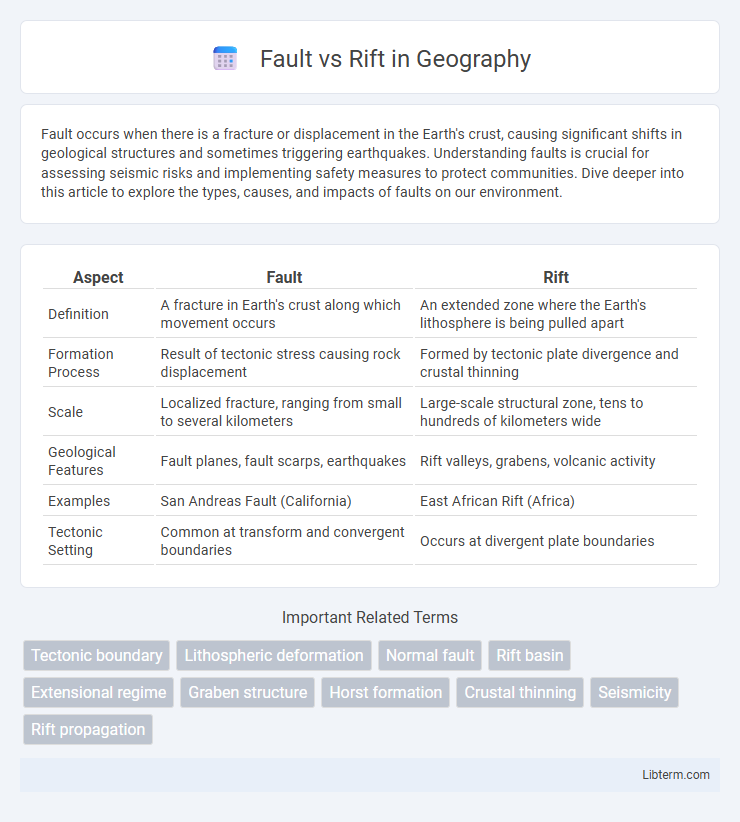Fault occurs when there is a fracture or displacement in the Earth's crust, causing significant shifts in geological structures and sometimes triggering earthquakes. Understanding faults is crucial for assessing seismic risks and implementing safety measures to protect communities. Dive deeper into this article to explore the types, causes, and impacts of faults on our environment.
Table of Comparison
| Aspect | Fault | Rift |
|---|---|---|
| Definition | A fracture in Earth's crust along which movement occurs | An extended zone where the Earth's lithosphere is being pulled apart |
| Formation Process | Result of tectonic stress causing rock displacement | Formed by tectonic plate divergence and crustal thinning |
| Scale | Localized fracture, ranging from small to several kilometers | Large-scale structural zone, tens to hundreds of kilometers wide |
| Geological Features | Fault planes, fault scarps, earthquakes | Rift valleys, grabens, volcanic activity |
| Examples | San Andreas Fault (California) | East African Rift (Africa) |
| Tectonic Setting | Common at transform and convergent boundaries | Occurs at divergent plate boundaries |
Introduction to Faults and Rifts
Faults are fractures in the Earth's crust where blocks of rock have slipped past each other due to tectonic forces, creating zones of displacement and potential seismic activity. Rifts are large-scale geological structures formed by the stretching and thinning of the crust, often leading to the formation of rift valleys and new tectonic plate boundaries. Understanding the formation and behavior of faults and rifts is essential for studying earthquake hazards and continental breakup processes.
Defining Faults: Structure and Formation
Faults are fractures in the Earth's crust along which significant displacement has occurred due to tectonic forces. They form when stress exceeds the rock's strength, causing brittle failure and creating a fault plane that accommodates horizontal, vertical, or oblique movement. Common fault types include normal, reverse, and strike-slip, each defined by the relative motion of fault blocks and associated stress regimes.
Understanding Rifts: Characteristics and Development
Rifts are large-scale geological features formed by the divergent movement of tectonic plates, characterized by elongated depressions and extensive crustal thinning. Unlike faults, which are fractures along which displacement occurs, rifts develop through a series of normal faults that create a broader zone of extension and subsidence. The process of rift development involves mantle upwelling, lithospheric stretching, and volcanic activity, leading to the formation of new ocean basins if extension continues.
Distinguishing Faults from Rifts
Faults are fractures in the Earth's crust along which significant displacement has occurred due to tectonic forces, whereas rifts are large-scale linear zones of crustal extension where the lithosphere is being pulled apart. Faults typically manifest as individual breaks or fault lines exhibiting vertical or horizontal movement, while rifts encompass broader zones characterized by multiple faults and subsidence forming elongated depressions or basins. Distinguishing faults from rifts involves recognizing that faults represent localized shear zones, whereas rifts are extensive areas of crustal thinning and divergence often associated with the early stages of continental breakup.
Geological Processes Behind Faults
Faults form through brittle deformation when rocks fracture under stress, allowing displacement along the break. Rifts develop from extensional tectonics, where the Earth's crust stretches and thins, leading to normal faulting and subsidence. These geological processes drive the formation of fault zones and rift valleys by accommodating crustal movements.
Rift Formation in Tectonic Plates
Rift formation occurs when tectonic plates move apart due to extensional forces, causing the Earth's lithosphere to thin and fracture. This process creates a rift valley characterized by normal faults and volcanic activity as magma rises to fill the space. Major examples include the East African Rift and the Mid-Atlantic Ridge, where ongoing rifting can eventually lead to the development of new ocean basins.
Types of Faults and Their Features
Faults are fractures in Earth's crust where blocks of rock have moved relative to each other, classified mainly as normal, reverse (thrust), and strike-slip faults based on their movement. Normal faults occur due to tensional forces causing the hanging wall to move downward relative to the footwall, typical in divergent boundaries. Reverse faults result from compressional forces pushing the hanging wall up over the footwall, common in convergent boundaries, while strike-slip faults involve horizontal displacement along transform boundaries.
Global Examples of Major Rifts
Major rifts such as the East African Rift, the Baikal Rift Zone in Russia, and the Rio Grande Rift in North America exemplify large-scale tectonic plate divergence, contrasting with faults which are fractures where plates slide past or against each other. The East African Rift spans over 6,000 kilometers, causing significant volcanic activity and shaping the landscape of countries like Ethiopia and Kenya. The Baikal Rift, one of the deepest continental rift zones, influences seismic activity around Lake Baikal, while the Rio Grande Rift extends approximately 1,200 kilometers from Colorado to Mexico, illustrating continental extension processes.
Seismic Activity: Faults vs Rifts
Faults are fractures in the Earth's crust along which significant displacement has occurred, often causing concentrated seismic activity due to the sudden release of stress. Rifts represent larger-scale zones where the crust is being pulled apart, generating distributed seismic events as the lithosphere thins and normal faults develop. Seismic activity along faults tends to produce sharper, localized earthquakes, whereas rift zones exhibit more frequent, moderate quakes associated with crustal extension.
Importance of Faults and Rifts in Earth’s Evolution
Faults and rifts play crucial roles in Earth's geological evolution, driving plate tectonics and shaping the planet's surface. Faults facilitate the movement of tectonic plates, leading to earthquakes that recycle crustal material and influence mountain-building processes. Rifts, where the Earth's crust is pulled apart, create new ocean basins and basins that promote biodiversity by forming diverse habitats.
Fault Infographic

 libterm.com
libterm.com